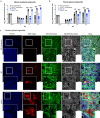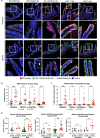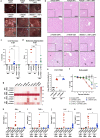Blockade of interferon signaling decreases gut barrier integrity and promotes severe West Nile virus disease
- PMID: 37749080
- PMCID: PMC10520062
- DOI: 10.1038/s41467-023-41600-3
Blockade of interferon signaling decreases gut barrier integrity and promotes severe West Nile virus disease
Abstract
The determinants of severe disease caused by West Nile virus (WNV) and why only ~1% of individuals progress to encephalitis remain poorly understood. Here, we use human and mouse enteroids, and a mouse model of pathogenesis, to explore the capacity of WNV to directly infect gastrointestinal (GI) tract cells and contribute to disease severity. At baseline, WNV poorly infects human and mouse enteroid cultures and enterocytes in mice. However, when STAT1 or type I interferon (IFN) responses are absent, GI tract cells become infected, and this is associated with augmented GI tract and blood-brain barrier (BBB) permeability, accumulation of gut-derived molecules in the brain, and more severe WNV disease. The increased gut permeability requires TNF-α signaling, and is absent in WNV-infected IFN-deficient germ-free mice. To link these findings to human disease, we measured auto-antibodies against type I IFNs in serum from WNV-infected human cohorts. A greater frequency of auto- and neutralizing antibodies against IFN-α2 or IFN-ω is present in patients with severe WNV infection, whereas virtually no asymptomatic WNV-infected subjects have such antibodies (odds ratio 24 [95% confidence interval: 3.0 - 192.5; P = 0.003]). Overall, our experiments establish that blockade of type I IFN signaling extends WNV tropism to enterocytes, which correlates with increased gut and BBB permeability, and more severe disease.
© 2023. Springer Nature Limited.
Conflict of interest statement
M.S.D. is a consultant or advisor for Inbios, Vir Biotechnology, Senda Biosciences, Ocugen, Topspin Therapeutics, Moderna, and Immunome. The Diamond laboratory has received unrelated funding support in sponsored research agreements from Vir Biotechnology, Emergent BioSolutions, and Moderna. J.-L.C. is an inventor on patent application PCT/US2021/042741 submitted by Rockefeller University that covers diagnosis of susceptibility to, and treatment of, viral disease and viral vaccines. The remaining authors declare no competing interests.
Figures





Similar articles
-
Autoantibodies neutralizing type I IFNs underlie West Nile virus encephalitis in ∼40% of patients.J Exp Med. 2023 Sep 4;220(9):e20230661. doi: 10.1084/jem.20230661. Epub 2023 Jun 22. J Exp Med. 2023. PMID: 37347462 Free PMC article.
-
Human type I interferons protect Vero E6 and ARPE-19 cells against West Nile virus and are neutralized by pathogenic autoantibodies.Sci Rep. 2025 Apr 2;15(1):11271. doi: 10.1038/s41598-025-89312-6. Sci Rep. 2025. PMID: 40175402 Free PMC article.
-
Viral pathogen-associated molecular patterns regulate blood-brain barrier integrity via competing innate cytokine signals.mBio. 2014 Aug 26;5(5):e01476-14. doi: 10.1128/mBio.01476-14. mBio. 2014. PMID: 25161189 Free PMC article.
-
West Nile virus infection in children.Expert Rev Anti Infect Ther. 2015;13(11):1373-86. doi: 10.1586/14787210.2015.1083859. Epub 2015 Aug 31. Expert Rev Anti Infect Ther. 2015. PMID: 26325613 Review.
-
West Nile virus neuroinvasive disease.Ann Neurol. 2006 Sep;60(3):286-300. doi: 10.1002/ana.20959. Ann Neurol. 2006. PMID: 16983682 Review.
Cited by
-
Inflammatory Response Associated with West Nile Neuroinvasive Disease: A Systematic Review.Viruses. 2024 Feb 29;16(3):383. doi: 10.3390/v16030383. Viruses. 2024. PMID: 38543749 Free PMC article.
-
Early cellular and molecular signatures correlate with severity of West Nile virus infection.iScience. 2023 Nov 2;26(12):108387. doi: 10.1016/j.isci.2023.108387. eCollection 2023 Dec 15. iScience. 2023. PMID: 38047068 Free PMC article.
-
West Nile Virus (WNV): One-Health and Eco-Health Global Risks.Vet Sci. 2025 Mar 19;12(3):288. doi: 10.3390/vetsci12030288. Vet Sci. 2025. PMID: 40266979 Free PMC article. Review.
-
Sterile production of interferons in the thymus.J Immunol. 2025 Jul 1;214(7):1468-1476. doi: 10.1093/jimmun/vkaf048. J Immunol. 2025. PMID: 40184034 Review.
-
Detection of autoantibodies against Interferon Type I in patients with autochthonous West Nile Virus encephalitis.Brain Behav Immun Health. 2025 Jul 30;48:101085. doi: 10.1016/j.bbih.2025.101085. eCollection 2025 Oct. Brain Behav Immun Health. 2025. PMID: 40799617 Free PMC article.
References
Publication types
MeSH terms
Substances
Grants and funding
LinkOut - more resources
Full Text Sources
Medical
Molecular Biology Databases
Research Materials
Miscellaneous

